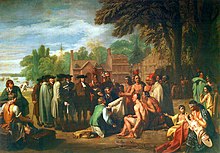Tamanend
| Tamanend | |
|---|---|

The Treaty of Penn with the Indians by Benjamin West, depicting Penn negotiating with Tamanend
|
|
| Lenni-Lenape leader | |
| Personal details | |
| Born | 1625 North America |
| Died | 1701 (aged 75–76) North America |
Tamanend or Tammany or Tammamend, the "affable", (c. 1625–c. 1701) was a chief of one of the clans that made up the Lenni-Lenape nation in the Delaware Valley at the time Philadelphia was established. Tamanend is best known as a lover of peace and friendship who played a prominent role in developing amicable relations among the Lenape and the English settlers who settled Pennsylvania, led by William Penn.
Also referred to as "Tammany", he became a popular figure in 18th-century America, especially in Philadelphia. Also called a "Patron Saint of America", Tamenend represented peace and amity. A Tammany society founded in Philadelphia holds an annual Tammany festival. Tammany societies were established across the United States after the American Revolutionary War, and Tammany assumed mythic status as an icon for the peaceful politics of negotiation.
Tamanend reputedly took part in a meeting between the leaders of the Lenni-Lenape nation, and the leaders of the Pennsylvania colony held under a large elm tree at Shakamaxon in the early 1680s. William Penn and Tamanend continued to sign seven more documents assuring each other, and their peoples, of peaceble understanding after the initial one in 1683. Tamanend is recorded as having said that the Lenni-Lenape and the English colonists would "live in peace as long as the waters run in the rivers and creeks and as long as the stars and moon endure." These words have been memorialized on the statue of Tamanend that still stands in Philadelphia. It is believed that Tamanend died in 1701. Over the next century, many folk legends surrounded Tamanend, and his fame assumed mythical proportions among the people of Philadelphia, who began to call him "King Tammany," "Saint Tammany," and the "Patron Saint of America." The people of Philadelphia organized a Tammany society and an annual Tammany festival. These traditions soon spread across America. Tammany's popular status was partly due to the desire by colonists to express a distinct "American" identity, in place of their former European nationalities. Tammany, an American Indian, provided an apt symbol for this kind of patriotism.
Because of Philadelphia's prominence during the American Revolution and subsequent decades, Tammany soon became a national symbol throughout much of the newly formed country.
In 1772, the original Tammany Society was formed in Philadelphia (it was originally called the "Sons of King Tammany" but was later renamed the "Sons of St. Tammany"). Soon, Tammany societies were organized in communities from Georgia to Rhode Island, and west to the Ohio River. The most famous of these was New York City's Society of St. Tammany, whose members developed an influential political machine known as "Tammany Hall." A white marble statue of Tamanend adorned the façade of the building on East 14th Street that housed Tammany Hall.
...
Wikipedia
